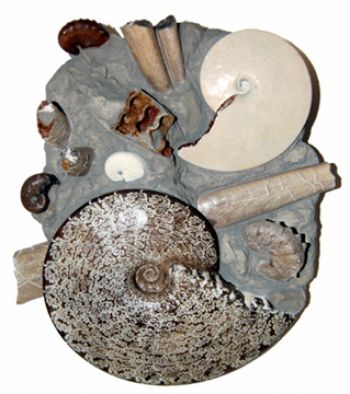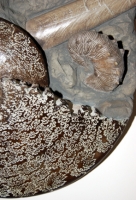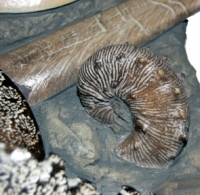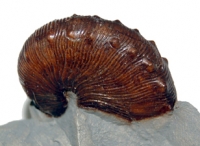
This wonderful mortality plate has 5 species of ammonites.
Placenticeras intercalare 8.5 inches across
Baculites compressus/cuneatus
Holoscaphites landesi
Jeletzkytes brevis
Rhaeboceras halli
They are from the Upper Cambrian, Fox Hills Formation of South Dakota, USA
The largest ammonite, Placenticeras is 8.5 inches across.
This specimen is a composite. It is meant to be a study of species which may be found loose or in the mud balls found along the Pierre Seaway. One of the theories on the formation of these mud balls is that they formed when portions of the bank eroded off and fell into the water. As it rolled, it picked up shells along the way to its final resting-place. This would also account for the random angles that the shells are found at within the mud balls when they are broken. Many mud balls have few or no shells within; while others have high concentrations of various sizes.
Ammonites and baculites belong to the Phylum Mollusca and the Class Cephalopoda. Cephalopod is Latin for head-foot. Cephalopods represent the largest, most intelligent and agile group of the Phylum Mollusca. They have a distinct head, large eyes, a funnel, and a circle of arms with a pair of grasping tentacles around the mouth or beak. The foot of the cephalopod has been modified into a funnel, which can be pointed in different directions. Water is taken into the mantle and expelled through the funnel. The cephalopod is then pushed in the opposite direction from which the funnel is pointing. All cephalopods, except for some octopi, have either an external shell in which the animal lives in the last chamber or an internal shell that is linearly chambered or reduced in size.
Ammonites are similar to today’s nautilus, and those of antiquity, in that they live in a chambered shell. As the animal grows it creates a new and larger chamber, closing off the old, smaller one. All the chambers are connected by a tube called a siphuncle which allowed the ammonite to rise or lower itself in the water. The chambers which the animal does not live in are called the phragmocone and are generally the parts which we find fossilized. Baculites were similar to ammonites except that after about one and a half coils the shell straightened out.
These cephalopods lived in a body of water known as the Pierre Seaway, which had depth ranging between 15 and 200 meters. This seaway ran through the middle of North America from Texas through Canada, including the states of Texas, New Mexico, Colorado, Nebraska, Kansas, Wyoming, Montana and the Dakotas.
polyresin
12x9.5"
Item 1187
Category: Replicas
Type: Skeletons
Phylum: Invertebrates
Class: Ammonites
MORE PHOTOS:




Now Over 1,000 Items!
PrehistoricStore.com offers the largest selection of replica fossils and other fossil-related products anywhere in the world!
Download a Full Catalog (3MB PDF)
OVER 260 PAGES OF REPLICAS AND MORE!
